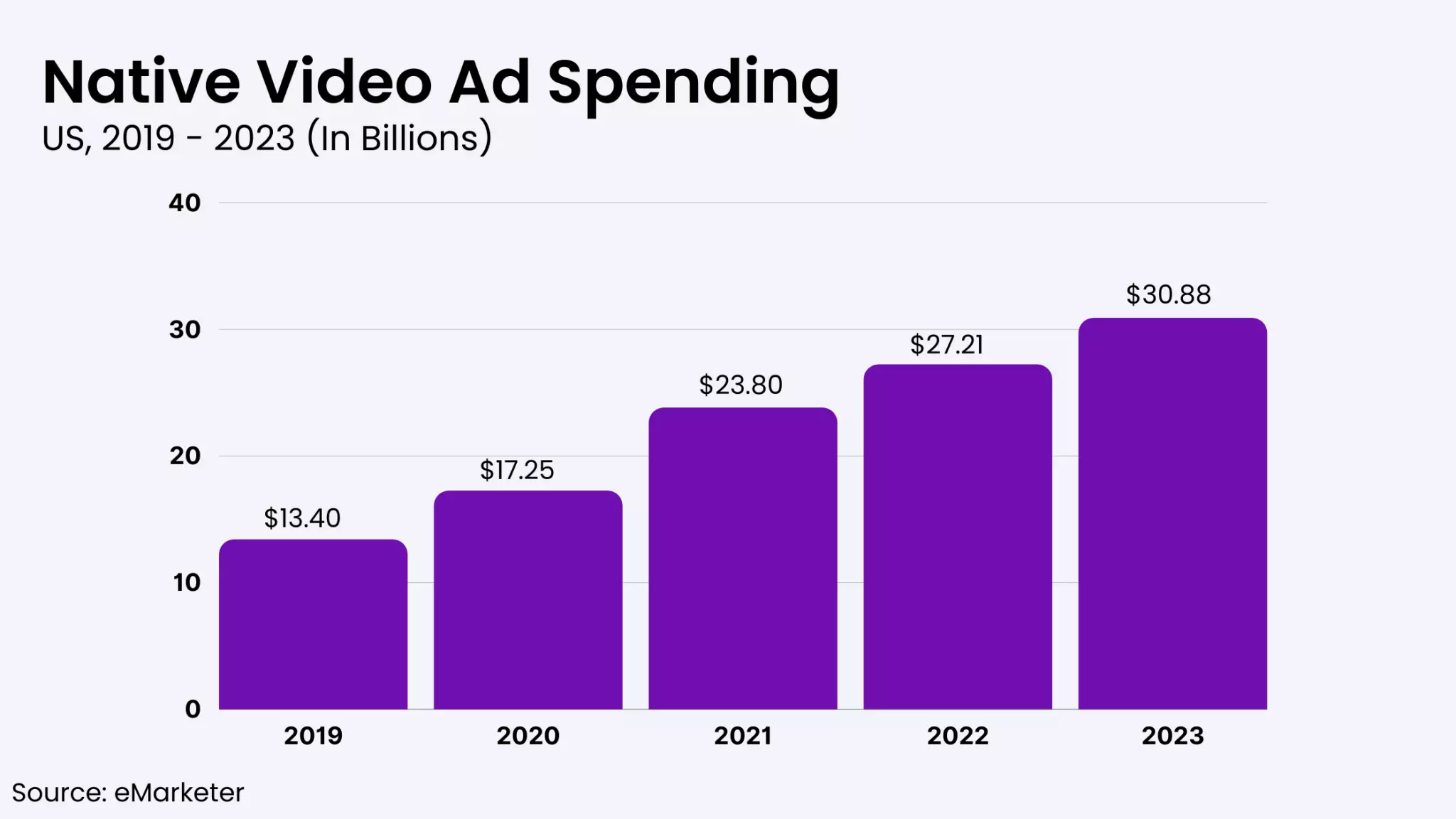Similar to display advertising, native advertising helps publishers to monetize their websites, and there’s no doubt that it will continue to woo both sellers and buyers in the ad tech industry. Before diving into what are mobile native ads and how to run them efficiently, we would like to clarify one thing – You can run native ads along with regular display ads. That being said, you need to measure and iterate to find the right balance between native ads and display ads.
According to eMarketer, native advertising spending reached $52.75 billion in 2020, a 24.6% YoY growth. Also, advertisers will spend $30.88 billion on native video ads in the U.S. this year. However, many publishers struggle to get started with native ads.

As mobile traffic continues to beat other devices’ traffic, we will focus on mobile native ads specifically in this piece. Of course, the process to start with native ads is the same for mobile/desktop/tablet.
Table of Contents
What Are Mobile Native Ads?
Mobile native advertising or mobile native ads enable digital publishers to run ads in the format of their website content, thus the name “native.” Native advertising is less intrusive because the ads are designed to blend in with the content of the host (website).
Generally, mobile native ads go by various names – Sponsored content, Promoted content, Paid content, etc. Here’s an example of a mobile native ad on Business Insider:
Best Mobile Native Ad Formats
Wondering what are the most popular mobile native ad formats? In general, IAB recommends five formats for mobile native advertising, and we’ve listed them here with examples:
In-feed (Content)
In-feed (Content) native ad format is best suited for editorial feeds, stories, and these ad formats are usually placed between the content available on a website.
Recommendation Widgets
These ads often appear as widgets at the end of an article or a page. You might have encountered these ads with headlines “You may also like,” “Recommended for you,” etc.
Generally, recommended mobile native ads don’t mimic the editorial content of a website and link to a different website (advertiser’s landing page). Publishers (and users) prefer to avoid them as clickbait articles lack quality (in most cases), and advertisers have reportedly experienced high invalid traffic activity when advertised via these widgets.
In-feed (Social)
This mobile native ad format is best suitable for social media feeds (Facebook, Pinterest, Twitter, Tumblr, etc.) where ads are made to fit with social media posts. The open web can’t use the format, but it’s a good example.
In-feed (e-commerce)
This ad format is used by e-commerce publishers/website owners. The ads (promoted products) are mixed with product listings, as shown below. E-commerce publishers prefer this advertising method since it displays products or deals relevant to visitors’ interests.
In-game
Mobile game publishers use this native ad format. Usually, these in-app or mobile web ads are optional for visitors. They can skip the ad and continue with the game. However, if seen, they get rewards in the form of points, lives, etc.
Get Started With Mobile Native Advertising
To run native ads (third-party) on your site, you must configure an ad server and connect with a native demand platform. On a higher level, this is how native ads are fetched.
In native advertising, advertisers’ ad servers provide different components of a native creative such as headline, landing page URL, images, and logo, instead of returning an ad tag*. The publisher’s ad server (e.g., Google Ad Manager) collects the components. It generates an ad that is appropriate to be served on mobile devices and fits with the surrounding content of the particular page.
*In the case of typical banner advertising, an advertiser provides an ad creative (an image or ad tag) with a fixed size via a third-party ad server. And Google Ad Manager, without making any changes to the ad, serves the ad in the stated size.
List of platforms that offer mobile native advertising:
- Sharethrough
- Outbrain (recommended widget)
- Taboola (recommended widget)
- Nativo
- TripleLift
- LoopMe
*The mentions aren’t recommendations, just a few examples.
Native Ads on Open Exchanges vs. Private Marketplaces
Mobile native ad demand can come from open ad exchanges or private marketplaces. It ultimately depends on the monetization partner you’re working with. Publishers tend to connect with native ad platforms (as mentioned above) to deliver such ads using Google Ad Manager.
Advantages of Mobile Native Ads
Native ads offer a bunch of advantages for publishers, including:
- As native ads enable publishers to display the ads with the same style and format as organic content, it increases ad view rates and the probability of user engagement.
- Native ads are merged with the content of a website. Hence, it enables readers to review the website’s content and advertisements without disruption.
- Mobile native ads, being less invasive, offer higher acceptance and click-through rates.
Sidenote: Ad creative matters a lot here. Without the intriguing content, users may scroll past the ads. Another drawback is the lack of distinction between organic content and digital ads – which might increase accidental clicks (higher bounce rate, lousy user experience).
Best Practices for Mobile Native Advertising
- Since native ads match the organic content of a website, ensure that ads provided by your demand partners are relevant to the page (contextual matching). After all, you wouldn’t want to place an irrelevant ad between your published quality content.
- The content format varies from one device to another (desktop, mobile, or tablet). So, personalize your native ads based on the screen sizes to create the best possible user experience. For instance, Google Ad Manager can render ads based on the screen size to ensure a native experience.
- Ensure that advertisers’ logos, headlines, and words like “sponsored,” “promoted,” “recommended,” etc. are visible to the users so that they can differentiate between the organic content and advertisements.
- Don’t go all-in with native ads without analyzing the user signals. It is always better to prioritize users over ads.
What’s Next?
Mobile native ads are compelling and can earn you better revenue. But it is equally important to consider user experience, existing display ads/video ads on the pages, and industry guidelines before implementing.
“I would urge advertisers to think about how to communicate [disclosure] to consumers while wanting the ad to be in the flow of what consumers are seeing.”
– Mary Engle, Associate Director of Advertising Practice, FTC
FTC has already warned publishers regarding the deceptiveness of native ads. As we always say, run, analyze, and iterate. There’s no one-size-fits-all solution in ad tech, and native ads may not get you better revenue than the programmatic display.























